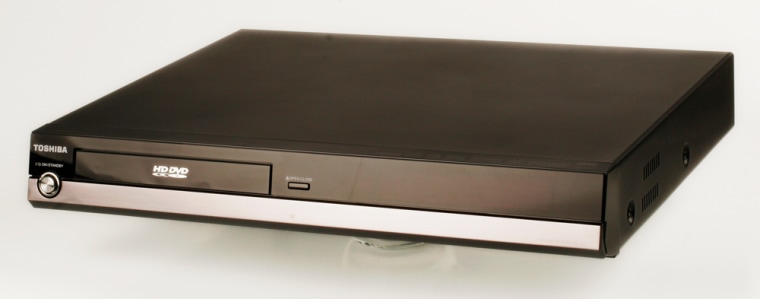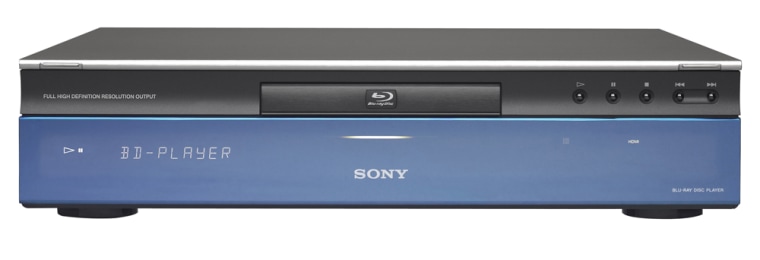The two movie disc formats that are competing to replace the DVD have had a rocky start, with clunky first-generation players and an audience that has been reluctant to buy them for fear of betting on the losing side.
But there’s now a second generation of players out, and in our test of three of them, it’s clear they left the problems of their predecessors behind. Sorry, consumers, but it’s time to choose sides: Blu-ray or HD DVD.
From the HD DVD camp I tried Toshiba Corp.’s $499 HD-A2 player. In the other corner of the ring swaggered Sony Corp.’s BDP-S1 Blu-ray disc player, which lists for $999 but is available for less. As a cheaper alternative, I also looked at the Blu-ray function of a $599 PlayStation 3 from Sony.
Our review of the first Toshiba HD DVD player, the HD-A1, in September noted that it was a massive affair that took a minute to start up and another to load the movie disc. The first Blu-ray player, from Samsung, was met by similar complaints, and appeared to degrade image quality slightly.
HD DVDs look sharp on Toshiba player
The HD-A2, by contrast, is a svelte device that looks very much like a regular DVD player. It takes 30 seconds to load a disc, a little slow but not enough to bore you. The fan is louder than you’d expect from a DVD player, but not bothersome in most entertainment centers.

HD DVDs looked, for the most part, fantastic on my 46-inch Sony LCD set, which is big enough to reveal the flaws in DVDs — they all look like they’re shot through a thin layer of jelly. “Deer Hunter” in HD DVD looked jaw-droppingly sharp and beautiful. An older movie like “Casablanca,” which has many medium shots, gained a dimension when I could clearly see the glints in the characters’ eyes.
The HD-A2 will pep up DVDs a little bit by “upconverting” them to faux high-definition, but for most discs, that only works if the player is connected to the TV by a digital High-Definition Multimedia Interface, or HDMI cable. The cheaper and more common three-lead component video cables won’t do. (Annoying fact: None of three devices I tested included a component or HDMI cable, just a standard-definition cable. If you want high-definition output from them, that’s about $30 extra!)
Sony Blu-ray player quieter

The HD-A2 doesn’t output the very highest-definition signal, called 1080p. The player is limited to a resolution of 1080i, which is 1080 lines of vertical resolution, with alternating lines refreshed every 60th of a second. If that doesn’t mean anything to you, don’t worry. My TV set is capable of showing 1080p, but I didn’t see a shred of difference between that and 1080i. If you really want 1080p output, Toshiba has another model, HD-XA2, that lists for $999.
The BDP-S1 is comparable to the HD-XA2. It’s a big, handsome box that makes you feel like you’re getting a lot for your $999. It was the quietest player in the test. The remote is easier to use and more substantial than the Toshiba’s. It loads a disc in 30 seconds, just like the HD-A2, and it can output 1080p.
Just one niggle: It was sometimes slow to respond to commands from the remote.
It also has a possible limitation in that, unlike the HD-A2 and the PlayStation, it does not connect to the Internet. The HD-A2 has an Ethernet jack for connecting the unit to an Internet router. The usefulness of that feature is not clear at the moment, though. Future HD DVD discs could connect to the Internet for special features like online games, and Toshiba may send software upgrades to the player that way.
Even so, the BDP-S1 is a fine machine. But I can’t quite recommend buying a PlayStation 3 for use exclusively as a Blu-ray player, mainly because it’s loud. Being more versatile than the other units, it contains more heat-generating chips, which means more ventilation is needed. The noise isn’t so loud that it will intrude on your movies, but it’s audible when nothing is playing, and it felt like a disharmonious, industrial element in the living room.
Expensive TV merits HD player
The PlayStation’s wireless controller is hard to use, so if you’re going to watch Blu-ray discs more than occasionally, I recommend getting Sony’s $25 video-style remote. If you have a good DVD player, keep it: The PlayStation does not upconvert DVDs.
The PlayStation does get a star for being the only unit that you can stand vertically, which might help if you’re short of space.
So both the stand-alone players are good. Should you get one? If you’ve spent $2,000 or more on an HDTV, I’d say yes. Get your money’s worth from your TV set.
It’s tougher to say which player to get. I liked the HD DVD player, and the discs had a more consistent image quality, probably because they use a more sophisticated mathematical formula, or codec, to pack the movie into the disc.
Blu-ray discs selling faster
Some Blu-ray movies showed slight smearing of colors in darker scenes, and “The Fifth Element,” an early disc, was overall not as crisp as it should have been. But the image quality of recent Blu-ray discs was a clear improvement, and the format has more support from Hollywood studios. Also, the PlayStation 3 is the most common HD player out there, so Blu-ray discs are selling faster than HD DVDs, according to Nielsen VideoScan.
Blu-ray appears to have the edge, but it’s still up in the air. What if the format you buy into turns out to be the Betamax of the matchup?
For one thing, you can minimize your risk by renting, not buying, discs. Netflix has every HD DVD and Blu-ray disc that’s out.
Secondly, consider this: In two years’ time, when you realize you’ve bet on the wrong horse, a player for the dominant format is going to cost maybe $200. Buy one, and keep your first player to play the “wrong” format discs you’ve bought.
See? There’s no reason to fear the format fight.
